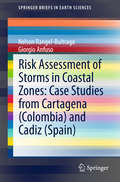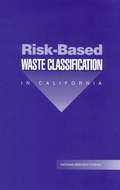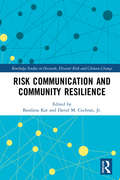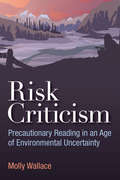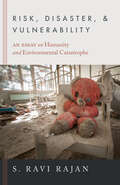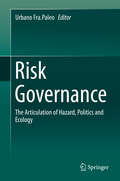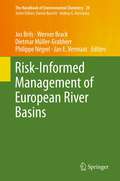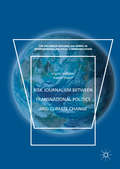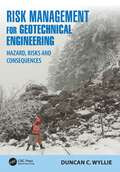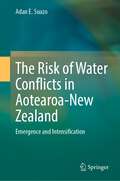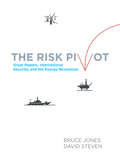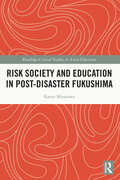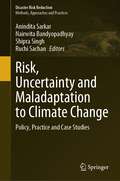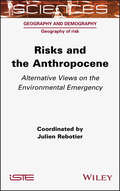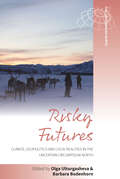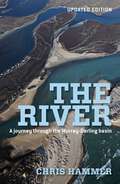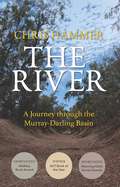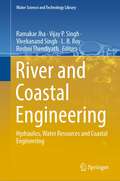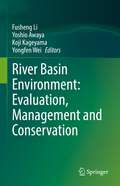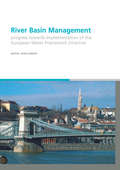- Table View
- List View
Risk Assessment of Storms in Coastal Zones: Case Studies from Cartagena (Colombia) and Cadiz (Spain)
by Nelson Rangel-Buitrago Giorgio AnfusoThis book assists the reader in determining storm risks, focussing on sandy coasts and cliff coasts in the context of expected sea level rise from littoral transformation and climate change. It examines storm impacts through matrixes concerning physical parameters, socio-economic activities, ecological and historic resources, and it presents the Coastline Risk to Storms Index as a single numerical measure of the risk for a given area. The methodology is described and tested against two coastal areas: one in the Caribbean Sea (Cartagena, Colombia) and the other on the coast of the Atlantic Ocean (Cadiz, Spain). Both areas record an important flow of tourists associated with the "sun, sea and sand market" which represents an economic recourse for the hinterland too. Chapters describe this approach and explore three particular types of variables: i) the forcing variables contributing to storm-induced erosion, ii) dynamic variables that determine the resilience to erosion (Susceptibility) and iii) the vulnerable targets grouped in three different contexts (socio-economic, ecological and heritage). These are combined into two separate indices, the Hazard Index (combining forcing and susceptibility) and the Vulnerability Index, which together constitute the Coastline Risk to Storms Index. Maps created using this semi-quantitative approximation method can help to determine the causes, processes and consequences of storm-related processes. This book is therefore important to anyone considering coastal development programs, especially decision-makers: the work presented here can assist in the development of preventative management strategies for the most vulnerable areas.
Risk-Based Waste Classification in California
by Committee on Risk-Based Criteria for Non-RCRA Hazardous WasteThe National Academies Press (NAP)--publisher for the National Academies--publishes more than 200 books a year offering the most authoritative views, definitive information, and groundbreaking recommendations on a wide range of topics in science, engineering, and health. Our books are unique in that they are authored by the nation's leading experts in every scientific field.
The Risk City
by Yosef JabareenContemporary cities face phenomenal risks, and they face particularly high levels of mounting social and environmental risks, including social polarization, urban conflicts, riots, terror, and climate change threats. This book suggests that climate change and its resulting uncertainties challenge the concepts, procedures, and scope of conventional approaches to planning, creating a need to rethink and revise current planning methods. Therefore, this book suggests a paradigm shift in our thinking, interrogation, and planning of our cities. Based on the contemporary conditions of risk at cities, this book conceptualizes the risk city as a construct of three interlinked concepts of risk, trust, and practice. It is a construct of risk and its new evolving conditions and knowledge of uncertainties stem from climate change and other risks and uncertainties. As a construct of practices, the risk city produces social and political institutional framework and promotes practices accordingly in order to reduce risk and risk possibilities and to increase trust. In light of the complex challenges and risks to the human habitat that have emerged in recent years, many cities have prepared various types of plans aimed at addressing the challenges posed by climate change. Nonetheless, despite the importance of these plans and the major public resources invested in their formulation, we still know little about them and have yet to begin studying them and assessing their contributions . From the innovative perspective of the risk city, this book asks critical questions about the nature, vision, practices, and potential impact of the recent climate change-oriented plans. What kinds of risks do they attempt to address, what types of practices do they institute, and what types of approaches do they apply? Do they adequately address the risks and uncertainties posed? How do they contribute to the worldwide effort to reduce greenhouse gas emissions? This book uses the methodologically innovative Risk City framework to examine the nature, vision, outcomes, practices, and impact of these crucial plans, as well as their contribution to the resilience of our cities and to global efforts toward reducing greenhouse gas emissions.
Risk Communication and Community Resilience (Routledge Studies in Hazards, Disaster Risk and Climate Change)
by Bandana Kar David M. CochranRisk communication is crucial to building community resilience and reducing risk from extreme events. True community resilience involves accurate and timely dissemination of risk information to stakeholders. This book examines the policy and science of risk communication in the digital era. Themes include public awareness of risk and public participation in risk communication and resilience building. The first half of the book focuses on conceptual frameworks, components, and the role of citizens in risk communication. The second half examines the role of risk communication in resilience building and provides an overview of some of its challenges in the era of social media. This book looks at the effectiveness of risk communication in socially and culturally diverse communities in the developed and developing world. The interdisciplinary approach bridges academic research and applied policy action. Contributions from Latin America and Asia provide insight into global risk communication at a time when digital technologies have rapidly transformed conventional communication approaches. This book will be of critical interest to policy makers, academicians, and researchers, and will be a valuable reference source for university courses that focus on emergency management, risk communication, and resilience.
Risk Conundrums: Solving Unsolvable Problems
by Roger E KaspersonA risk conundrum can be viewed as a risk that poses major issues in assessment, and whose management is not easily engaged. Such perplexing problems can either paralyze or badly delay risk analysis and directions for progression. Rather than simply focusing on the progress in risk analysis that has already been made, it is crucial to consider what has been learnt about these seemingly unmanageable problems and how best to move forward. <P><P> Risk Conundrums seeks to answer this question by bringing together a range of key thinkers in the field to explore key issues such as risk communication, uncertainty, social trust, indicators and metrics, and risk management, drawing upon case study examples including natural disasters, terrorism, and energy transitions. The initial chapters address risk conundrums, their properties, and the challenges they pose. The book then turns to a greater emphasis on systemic and regional risk conundrums. Finally, it considers how risk management can be changed to address these unsolvable conundrums. Alternative pathways are defined and scrutinized and predictions for future developments set out. <P><P> This book will be of great interest to students and scholars of risk governance, environmental policy, and sustainable development.
Risk Criticism: Precautionary Reading in an Age of Environmental Uncertainty
by Molly WallaceRisk Criticism is a study of literary and cultural responses to global environmental risk in an age of unfolding ecological catastrophe. In 2015, the Bulletin of the Atomic Scientists reset its iconic Doomsday Clock to three minutes to midnight, as close to the apocalypse as it has been since 1953. What pushed its hands was not just the threat of nuclear weapons, but also other global environmental risks that the Bulletin judged to have risen to the scale of the nuclear, including climate change and innovations in the life sciences. If we may once have believed that the end of days would come in a blaze of nuclear firestorm, we now suspect that the apocalypse may be much slower, creeping in as chemical toxins, climate change, or nano-technologies run amok. Taking inspiration from the questions raised by the Bulletin's synecdochical "nuclear," Risk Criticism aims to generate a hybrid form of critical practice that brings "nuclear criticism" into conversation with ecocriticism. Through readings of novels, films, theater, poetry, visual art, websites, news reports, and essays, Risk Criticism tracks the diverse ways in which environmental risks are understood and represented today.
Risk, Disaster, and Vulnerability: An Essay on Humanity and Environmental Catastrophe
by S. Ravi RajanOver the course of the past century, there has been a sustained reflective engagement about environmental risks, disasters, and human vulnerability in our modern industrial world. This inquiry has raised a host of crucial questions. Just how safe is humanity in a world of toxic chemicals and industrial installations that have destructive potential? Is it feasible to prevent large-scale catastrophes like the ones in Bhopal, Chernobyl, and Fukushima and smaller-scale disasters such as oil spills and gas leaks? How do environmental hazards affect social and political orders? S. Ravi Rajan expertly synthesizes decades of public policy and academic discourse on how societies measure and ultimately come to terms with risk, danger, and vulnerability and offers a fresh, humanistic perspective for grappling with the new global scale and interconnectedness of these threats.
Risk Governance
by Urbano Fra. PaleoThis book explores the common language of politics, ecology and risk, and crosses their conceptual divides. It seeks to shed light on the underlying structural factors, processes, players and interactions in the risk scenario, all of which influence decision-making that both increases and reduces disaster risk. The first section explores risk governance under conditions of increasing complexity, diversity and change. The discussion includes chapters on The problem of governance in the risk society; Making sense of decentralization; Understanding and conceptualizing risk in large-scale social-ecological systems; The disaster epidemic and Structure, process, and agency in the evaluation of risk governance. Part II, focused on governance in regions and domains of risk, includes nine chapters with discussion of Climate governance and climate change and society; Climate change and the politics of uncertainty; Risk complexity and governance in mountain environments; On the edge: Coastal governance and risk and Governance of megacity disaster risks, among other important topics. Part III discusses directions for further advancement in risk governance, with ten chapters on such topics as the transition From risk society to security society; Governing risk tolerability; Risk and adaptive planning for coastal cities; Profiling risk governance in natural hazards contexts; Confronting the risk of large disasters in nature and Transitions into and out of a crisis mode of socio-ecological systems. The book presents a comprehensive examination of the complexity of both risk and environmental policy-making and of their multiple--and not always visible--interactions in the context of social-ecological systems. Just as important, it also addresses unseen and neglected complementarities between regulatory policy-making and ordinary individual decision-making through the actions of nongovernmental actors. A range of distinguished scholars from a diverse set of disciplines have contributed to the book with their expertise in many areas, including disaster studies, emergency planning and management, ecology, sustainability, environmental planning and management, climate change, geography, spatial planning, development studies, economy, political sciences, public administration, communication, as well as physics and geology.
Risk-Informed Management of European River Basins
by Philippe Négrel Dietmar Müller Werner Brack Jos Brils Jan E. VermaatThe growing impacts of economic activities and climate change on the conditions of rivers throughout the world, require a new, integrated approach towards river basin management, an approach that can also cope with an uncertain future. In this volume, leading European scientists and representatives of major stakeholder groups present risk-informed management as this new approach, as developed in the European Commission-funded project RISKBASE. It aims to improve the ecological quality of river basins and thus to sustain the goods and services they provide for the benefit of society. Risk-informed management involves the integrated application of three key-principles: · Being well informed · Managing adaptively · Pursuing a participatory approach The authors explain and underpin these principles in detail, offer inspiring examples from practice and connect them to the implementation of the European Water Framework Directive (WFD). This book is intended for scientists, consultants and practitioners concerned about river basins, world-wide, as well as the drafters and implementers of the WFD River Basin Management Plans.
Risk Journalism between Transnational Politics and Climate Change (The\palgrave Macmillan Series In International Political Communication Ser.)
by Kasim Sharif Ingrid VolkmerThis book introduces a new methodology to assess the way in which journalists today operate within a new sphere of communicative ‘public’ interdependence across global digital communities by focusing on climate change debates. The authors propose a framework of ‘cosmopolitan loops,’ which addresses three major transformations in journalistic practice: the availability of ‘fluid’ webs of data which situate journalistic practice in a transnational arena; the increased involvement of journalists from developing countries in a transnationally interdependent sphere; and the increased awareness of a larger interconnected globalized ‘risk’ dimension of even local issues which shapes a new sphere of news ‘horizons.’ The authors draw on interviews with journalists to demonstrate that the construction of climate change ‘issues’ is increasingly situated in an emerging dimension of journalistic interconnectivity with climate actors across local, global and digital arenas and through physical and digital spaces of flows.
Risk Management for Geotechnical Engineering: Hazard, Risks and Consequences
by Duncan C. WyllieRisk Management for Geotechnical Engineering: Hazard, Risks and Consequences covers the application of risk management for soil and rock engineering projects, and the preparation of reliable designs that account for uncertainty.The book discusses qualitative risk assessments based on experience and judgement, as well as quantitative risk analysis using probabilistic methods and decision analysis to optimize designs. Many examples are included of how risk management can be applied to geotechnical engineering, with case studies presented for debris flows, rock falls, tunnel stability, and dam foundations. Also discussed are issues of liability insurance and contract law related to geotechnical engineering.This comprehensive book is ideal for practicing geotechnical engineers, addressing the challenges of making decisions in circumstances where uncertainties exist in site conditions, material properties and analysis methods.
The Risk of Water Conflicts in Aotearoa-New Zealand: Emergence and Intensification
by Adan E. SuazoThis book focuses on water disputes in New Zealand: a country where such conflicts are assumed to be non-existing. Rarely are water disputes examined in areas where water resources abound, and where the political framework that governs their access and use is strong. Environmental security literature has devoted a significant amount of attention to the nexus between resource abundance and conflict. Important research has assessed this relationship by focusing on non-renewable resource wealth as a causal determinant of conflict, but little is known about the conditions that influence the emergence and intensification of conflict in water abundant environments. By most accounts, New Zealand is one of the most water-rich countries in the world. Even though violent conflict over water does not normally materialize in New Zealand, conflicts and incompatible claims motivated by water bottling, the growth of some types of agriculture, tourism, and water treatment strategies, continue to surface. Little, however, is known about how and why these conflicts emerge and intensify in a country such as New Zealand. To address this lacuna, this project asks the following research question: How and why does the commercialization of freshwater influence the emergence and intensification of hydropolitical conflict in New Zealand? This study presents two central arguments. First, that the introduction of a commercial enterprise motivates the emergence of hydropolitical conflict intentionality if the enterprise is incompatible with the interests of local communities. And second, hydropolitical conflict risk intensifies in accordance with the level of trust that communities pose upon the approval and appeals process that supports a commercial operation. To test these arguments, this study examines the effects of water bottling and water chlorination on the towns of Ashburton (Canterbury) and Glenorchy (Otago), by employing a tripartite analysis comprised, first, of a conflict intentionality and engagement assessment, second, of a comparative case study analysis, and third, of a conflict intentionality classification. The data suggests that hydropolitical conflict risk is low when communities trust the approval and appeals process behind any given commercial operation. Water-based conflict risk however is likely to escalate when local communities lose trust in the above processes and the institutions that administer them.
The Risk Pivot
by Bruce D. Jones David StevenThe last decade has seen a revolution in global energy. First, we saw explosive growth in demand from Asia's rising powers, which fueled fears about scarcity and conflict. But we've also seen an American revolution in technology and markets, resulting in a dramatic increase in sup-ply. This is strengthening America's hand in the world-but it's not without complications. There are major security consequences of these shifts. Among the most consequential are China and India, Asia's emerging giants, which are increasingly exposed to political risks associated with energy risks, as well as the energy flows, pivoting to Asia. Meanwhile the great powers struggle to balance their need for fossil fuels with a mounting effort to tackle climate change. The top powers, and the United States above all, face a stra-tegic choice: whether to use energy as a weapon of geopolitics, or as a tool of a stable order.CONTENTSIntroduction1. The President and the King-Key Messages of the Book2. The Energy Revolutions-A PrimerGeopolitics in Flux-The Players3. Choices-Scenarios, and the Choice the Powers Confront4. Rough Seas Ahead-The Great Powers' Search for Energy SecurityGlobalization and Complexity-The Problems5. Transition in the Gulf6. The Turbulent Middle7. Fragile States8. The Russian Problem9. Connections-from Pipelines to PoliticsGovernance-The Partners10. An Emerging System of Global Energy Governance11. Leadership Choices
The Risk Pivot
by David Steven Bruce D. JonesThe last decade has seen a revolution in global energy. First, we saw explosive growth in demand from Asia's rising powers, which fueled fears about scarcity and conflict. But we've also seen an American revolution in technology and markets, resulting in a dramatic increase in sup-ply. This is strengthening America's hand in the world--but it's not without complications. There are major security consequences of these shifts. Among the most consequential are China and India, Asia's emerging giants, which are increasingly exposed to political risks associated with energy risks, as well as the energy flows, pivoting to Asia. Meanwhile the great powers struggle to balance their need for fossil fuels with a mounting effort to tackle climate change. The top powers, and the United States above all, face a stra-tegic choice: whether to use energy as a weapon of geopolitics, or as a tool of a stable order.CONTENTS Introduction1. The President and the King--Key Messages of the Book2. The Energy Revolutions--A PrimerGeopolitics in Flux--The Players3. Choices--Scenarios, and the Choice the Powers Confront4. Rough Seas Ahead--The Great Powers' Search for Energy SecurityGlobalization and Complexity--The Problems5. Transition in the Gulf6. The Turbulent Middle7. Fragile States8. The Russian Problem9. Connections--from Pipelines to PoliticsGovernance--The Partners10. An Emerging System of Global Energy Governance11. Leadership Choices
Risk Society and Education in Post-Disaster Fukushima (Routledge Critical Studies in Asian Education)
by Kaoru MiyazawaIn response to the explosion of the Fukushima Daiichi power plant in March 2011, this book examines how the concept of a risk society was handled in the various education programs implemented in post-disaster Fukushima. The explosion and subsequent radiation contamination that affected the biosphere of the Fukushima region and beyond, revealed that we live in a risk society. Despite this revelation, official discourses in Fukushima have been geared strictly toward the future, with the aim of restoring communities and resuming development projects. Based on the ethnographic data the author collected in Fukushima between 2013 and 2016, various contested emotions emerged in those education spaces as students and teachers remembered their romanticized and difficult past and dealt with the challenges presented by the risk society in their present lives. The emotionally-charged interactions between past and present also shaped their vision of their future community and of the actions they might take. The dialogues and actions that took places in these education spaces encourage readers to examine the meaning of development and question the basic assumptions and methods of education as society shifts to a risk society. A valuable resource for scholars and students in the fields of globalization and education, curriculum studies, sociology of education, and Japanese studies.
Risk, Uncertainty and Maladaptation to Climate Change: Policy, Practice and Case Studies (Disaster Risk Reduction)
by Anindita Sarkar Nairwita Bandyopadhyay Shipra Singh Ruchi SachanThis book focuses on integrated disaster risk reduction arising out of climate change and shows how communities build resilience through adaptive and transformative strategies at the local and global levels. It integrates disaster risk, uncertainty, and maladaptation to climate change with evidence from empirical research and a systematic review of existing studies. The book also proposes two important contributions, which makes it distinctive. First, it gives a systematic review of the literature to capture the changing context and concept of risk, uncertainty, and maladaptation to climate change. Second, it uses case studies from around the globe to demonstrate the ways that communities have fostered to build resilience to mitigate the impacts of climate change.There is a growing recognition that decision-makers often rely on intuitive thinking processes rather than undertaking a systematic analysis of options in a deliberative fashion. This latter approach requires accepting a plurality of narratives, embracing multiple disciplinary perspectives, and above all, integrating the appropriate disciplines that can help in finding better solutions. Thus, the book adds value to the existing knowledge on climate change adaptation, perception, and policy initiatives to address disaster risk reduction. It considers all these interconnected issues of risk, uncertainty, and maladaptation through a series of conceptual review- and evidence-based case studies to create new knowledge to address climate change adaptation and a resilient future. The book is a useful contribution to resilience scientists, policymakers, and practitioners from diverse disciplines.
Risks and the Anthropocene: Alternative Views on the Environmental Emergency
by Julien RebotierThe Anthropocene refers to all societies’ current era of environmental challenges. For the social sciences, the Anthropocene represents a historical “moment” with huge potential: it offers people new ways of considering the human condition, as well as how they interact with the rest of the living world and with the planet on all levels. At the turn of the 21st century, the idea of the Anthropocene burst onto the older, diverse and varied scene of risk studies.This “new geological era”, which is entirely created by humanity, went on to revive our understanding of environmental issues, as well as the analysis of the social and political problems that constitute risk situations.Drawing together contributions from specialists in social sciences concerning risks and the environment, Risks and the Anthropocene explores the advantages that the idea of the Anthropocene can offer in understanding risks and their management, as well as the limitations it presents.
Risks, Rewards and Regulation of Unconventional Gas
by Grafton R. Quentin Cronshaw Ian G. Moore Michal C.The global energy transition from carbon-intensive to renewable fuels has increasingly demanded a better understanding of the causes and consequences of the rapid development of unconventional oil and gas. Focusing on key countries including the US, Canada, China, Argentina, the UK and Australia, this book consists of case studies and in-depth analyses that weigh up the risks and rewards at regional, national and global scales. Explaining how and why unconventional fuels are transforming the global energy landscape, the strengths, weaknesses, opportunities and threats are explored through a political, economic and governance-based perspective. Emphasis is placed on how to regulate the industry, encompassing local issues, stakeholder engagement and the social licence to operate. The new baseline studies and standards introduced in this book provide a timely insight into the trade-offs across the social, economic and environmental domains, making this ideal for researchers and policymakers in energy fields, and for graduate students.
Risky Futures: Climate, Geopolitics and Local Realities in the Uncertain Circumpolar North (Studies in the Circumpolar North #6)
by Olga Ulturgasheva Barbara BodenhornThe volume examines complex intersections of environmental conditions, geopolitical tensions and local innovative reactions characterising ‘the Arctic’ in the early twenty-first century. What happens in the region (such as permafrost thaw or methane release) not only sweeps rapidly through local ecosystems but also has profound global implications. Bringing together a unique combination of authors who are local practitioners, indigenous scholars and international researchers, the book provides nuanced views of the social consequences of climate change and environmental risks across human and non-human realms.
Rites of Love (The Ringing Cedars Series #8, Part #2)
by Vladimir Megré John Woodsworth Leonid SharashkinThis book is a call to research, to becoming aware of the Divine programme.
River: A Journey Through The Murray-Darling Basin
by Chris HammerIn The River, Chris Hammer takes us on a journey through Australia's heartland, following the rivers of the Murray-Darling Basin, recounting his experiences, his impressions, and, above all, stories of the people he meets along the way. It's a journey punctuated with laughter, sadness and reflection. The River looks past the daily news reports and their sterile statistics, revealing the true impact of our rivers' decline on the people who live along their shores, and on the country as a whole. It's a tale that leaves the reader with a lingering sense of nostalgia for an Australia that may be fading away forever.
The River: A Journey through the Murray-Darling Basin
by Chris HammerAustralia's major river system is collapsing. Parts of it are dying; parts of it are already dead. Australia's most significant river no longer reaches the sea. I look out into the dim autumn light and wonder once again how it has come to this . . . Join award-winning author Chris Hammer on a journey through Australia's largest river system, the Murray-Darling Basin. His travels during the crippling millennium drought take us through riverland communities, sharing the laughter, sadness and reflections of the people he meets along the way. The River looks past the daily news reports and their sterile statistics to reveal the true impact of our rivers' decline on the people who live along their shores, and on the country as a whole. It's a tale that leaves the reader with nostalgia for an Australia that may be fading away forever. First published in 2010, The River continues to be read as a history, as a prophecy – and as both. This updated edition includes a new introduction from the author.
River and Coastal Engineering: Hydraulics, Water Resources and Coastal Engineering (Water Science and Technology Library #117)
by Ramakar Jha Vijay P. Singh Vivekanand Singh L. B. Roy Roshni ThendiyathThis book deals with important topics of current interest, such as climate change, floods, drought, and hydrological extremes. The impact of climate change on water resources is drawing worldwide attention in these days; water resources in many countries are already stressed and climate change along with burgeoning population, rising standard of living, and increasing demand are adding to the stress. Further, river basins are becoming less resilient to climatic vagaries. Fundamental to addressing these issues is hydrological modelling which is covered in these books. Further, integrated water resources management is vital to ensure water and food security. Integral to the management is groundwater and solute transport. The books encompass tools that will be useful to mitigate the adverse consequences of natural disasters. This book is useful for those working in river and coastal engineering. River Engineering is important for fluvial hydraulics, sediment transport, morphometry, desilting, trap efficiency, silting and desilting process. Coastal engineering includes storm surge forecast, optimization of harbour, wave modelling, and shoreline changes.
River Basin Environment: Evaluation, Management and Conservation
by Fusheng Li Yoshio Awaya Koji Kageyama Yongfen WeiThis book provides updated and comprehensive information on the evaluation of the river basin environment, along with its management and conservation. The chapters collected the latest cutting-edge research achievements in vegetation function evaluation, remote sensing monitoring and analysis, water quality evaluation and control, water and wastewater treatment, soil remediation, forest resource management, microbial disease diagnosis and more, the key components that link directly with the safety, security and sustainability of river basin environment. This book emphasizes the important aspects for better and more effective evaluation, management and conservation of the river basin environment, the foundation for its sustainable utilization and development, the foundation for achieving water and food security, and the United Nations’ SDGs for No Poverty (1), Zero Hunger (2) and Clean Water and Sanitation (6), as well as Affordable and Clean Energy (7), Sustainable Cities and Communities (11), Climate Action (13), Life below Water (14) and Life on Land (15). This book will benefit the research community and environmental education. It will prove useful to students, water and forest resource managers, hydrologists and all those engaged or interested in any aspect of evaluation, management, and conservation of the river basin environment. The book also has the potential to inform multi-regional and sectoral policies in all regions of the world and contribute to sustainable development solutions through better management of water, soil, and vegetation resources.
River Basin Management: Progress Towards Implementation of the European Water Framework Directive
by John LawsonRiver Basin Management is a collection of papers presented at a conference on implementation of the EU Water Framework Directive, held in Budapest in May 2005. The Water Framework Directive requires progressive protection and enhancement to rivers, lakes, estuaries, coastal waters and wetlands by the year 2015. At the heart of this major new piece of legislation is the requirement for all EU member states to prepare river basin management plans for all river basin catchments, providing the basis for coordinated improvements to water management, leading to better water quality and sustainable aquatic environments in lakes and rivers. The papers cover a wide range of topics including pilot studies for the development of river basin management plans, public participation in the planning process, water quality monitoring, modeling and analysis, identifying and addressing pollution and meeting environmental objectives. The book presents an array of experience from eighteen European countries in the implementation of the EU’s most far reaching environmental legislation. It is an invaluable source of information and ideas for the widespread preparation of river basin management plans now starting throughout Europe.
